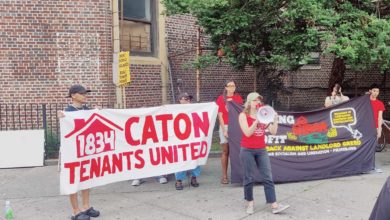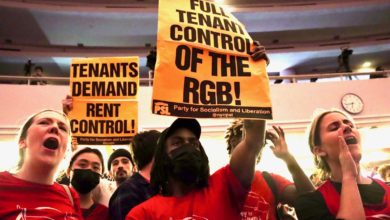All
class societies, whether ancient slavery, feudalism or capitalism,
have been based on exploitation of human labor. A few own and control
the surplus produced
by the labor of the many. Within capitalist society, the ownership of
capital by one class and not the other results in an ever-increasing
polarization between the capitalists and the workers.
Increasing
polarization between rich and poor is a determining factor in the
rapid decline of the Black community in the District of Columbia.
In the last decade,
the number of African Americans living in the District declined by 11
percent, according to statistics released last month by the U.S.
Census Bureau. “Barely 50 percent of the District’s population
was African American in 2010—a remarkable shift in a place once
nicknamed ‘Chocolate City.’” (Washington Post, March 24)
But, when
discussing the decline in the District’s Black population, we must
never forget that this is only possible through the continuation of a
societal system that places profits over the needs of people; and
often those most affected are people of color. But we must also
recognize that Blacks, like Asians, Latinos and all other oppressed
nationalities, are divided into classes. And those who represent the
capitalist class within the District have a vested interest in the
continued accumulation of profit.
In 1970, seven out
of 10 Washingtonians were Black, according to the Washington Post.
Today, the Black population is barely half. Gentrification is the
primary source of the decline in the Black population as
opportunities dwindle and the cost of living rises. In the past
decade, the appeal by white and Black politicians for investment and
business has in turn caused the city to become an unaffordable place
of residence for many in the Black community.
When the Residence
Act of 1790 that formally established the building of the nation’s
capital was passed, Black slaves outnumbered their white owners by
more than four to one. On their backs came the beginnings of
Washington, D.C.
Though Blacks were
indispensable to the building of this city, their living conditions
were appalling. Black slaves lived in hastily erected shacks near the
White House and Capitol worksites. Later, the burgeoning free Black
population was forced to live in alley houses that were subsequently
dubbed unfit for human habitation.
Some 230 years
later, African Americans still do not receive respect and dignity
from the city they helped build. Still, Washington, D.C., has been a
beacon of hope in the African American community across the country.
It has been known as one of the centers of Black culture and the
ability of African Americans to eke out a living.
During the 1950s,
the Federal Housing Administration provided millions of dollars to
expand the “middle class” in the United States. While African
Americans were an integral part of the Washington community, they
were often excluded from this program. Thus, the federal government
reinforced the idea that African Americans must remain part of the
poor working-class sector of society.
First
majority-Black major U.S. city
In 1957, when
Marion Barry first came to Washington, D.C., “it had become the
first major U.S. city with a majority-black population.” (“Between
Justice and Beauty: Race, Planning, and the Failure of Urban Policy
in Washington, D.C.,” by Howard Gillette Jr, 1995)
After working in
Washington on the school board, Barry would be elected mayor. His
primary focus became the creation of jobs and his appeal to the poor
Black community of the city. Unlike his Black middle-class opponents,
he focused on making alliances with the gay community. In addition,
he worked with then-Secretary of Labor Willard Wirtz on securing
funds to “train hard-core unemployed youth in Washington.”
(ibid.)
His jobs program
for youth is still a hallmark of his mayoral career. In addition, he
organized successfully against a bus fare hike and helped thwart an
urban renewal highway plan that would have displaced Black residents.
His focus on empowering the Black community had a dramatic affect on
the ability of African Americans to improve their overall economic
status.
But what is often
forgotten is that Barry was mayor when urban renewal of the District
began. While uniting the Black community around his jobs campaign, he
simultaneously began the process of gentrification, particularly with
the building of the MCI Center and Gallery Place.
In the most recent
period, leaders within the Black community have begun to identify
with the ruling class on a larger scale. This has had a drastic
effect on the removal of African Americans from the Washington area.
Anthony Williams,
who followed Barry as mayor, initially proposed the building of a
$400 million publicly funded baseball stadium in the District. By
2007, the funding of this stadium rose to $611 million. This came at
a time when Washingtonians were told there was no funding for
homeless shelters and other vitally needed services. Positive Nature,
a non-profit community organization, was forced to move due to the
new publicly funded baseball stadium, as their property taxes
increased by 900 percent.
And then Adrian
Fenty, who followed Williams as mayor, cut hundreds of jobs in
education through school closures. These jobs provided security and
the affordability to live in the District. As these jobs disappeared
or were cut from the budget, segments of the African American
community also disappeared.
Lack of jobs for
lower-income residents
A primary reason
for increasing gentrification is the lack of jobs for lower-income
residents. And those jobs that did exist are either being eradicated
or outsourced to private entities. Barry, now a member of the City
Council, recently told the Washington Post: “We’re going to stop
this trend—gentrification. … We can’t displace old-time
Washingtonians.” (March 25)
Current Mayor
Vincent Gray also proposes jobs as the solution to increased job loss
and the inability of African Americans to afford to live in the
District. However, with all the massive budget cuts and outsourcing,
the jobs that remain are primarily in the low-wage service sector.
And the jobs that remain will still be within a society whose basis
is deriving profit for those who do not work.
While Gray and
Fenty may have their heartstrings pulled due to the atrocities being
committed against the Black community, they are still the face of the
ruling class in the District. And in order to hold that position,
they must support the interests of those in power.
We must form a
fight-back movement against those who are trying to destroy the
foundation of the Washington community—the African American
population’s right to exist in the District. While jobs are the
starting point, the overall loss of jobs and well-being in the
District promote a familiar refrain inside American political life.
There are those who
blame this problem on lack of personal initiative and say that
everyone has opportunities and should pull themselves up by their
bootstraps. But what these numbers show more than anything is the
lack of opportunity. Even during the so-called economic boom, it was
almost impossible for young African Americans to find jobs. Contrary
to popular belief, most job growth since the early1980s has been in
the service sector—low paying, so-called unskilled labor.
This has increased
the gap between rich and poor overall, but for African Americans in
the inner city it is worse. Education, even though it is the vaunted
ticket out of poverty and despair, is also not the option you might
think. Inner-city schools are most often in horrible disrepair and
have outdated textbooks and not enough teachers. This causes many
students to fall behind early with no chance of catching up. Here in
Washington, we know that to be the case, as Gray just announced that
almost half of all D.C. public schools would lose an average of $500
per student.
One of the goals of
Marxism is to help every sector of the working class understand its
position in capitalist society. That position is clearly revealed in
times of capitalist crisis. As individuals, we have no power; as
people divided by our ethnicity or nationality, we also have none. As
long as each worker is reduced to an individual trapped in the system
of capitalist wage slavery, we are at the mercy of the bosses. As
long as we as a class are divided by racism—a tool of the
capitalist system—we are at the mercy of the bosses.
We must recognize
that these so-called leaders are in fact the face of the capitalist
system. Rather than blaming teachers for the decrease in school
funding, we should stand with them as they face continual attacks.
Instead of looking to Gray or any capitalist politician to solve the
problems of the Black community, we must look to ourselves.
As a collective—as
a class—we are strong if we organize together. United, we can build
a movement to stop this onslaught on the Black community of
Washington, D.C.






